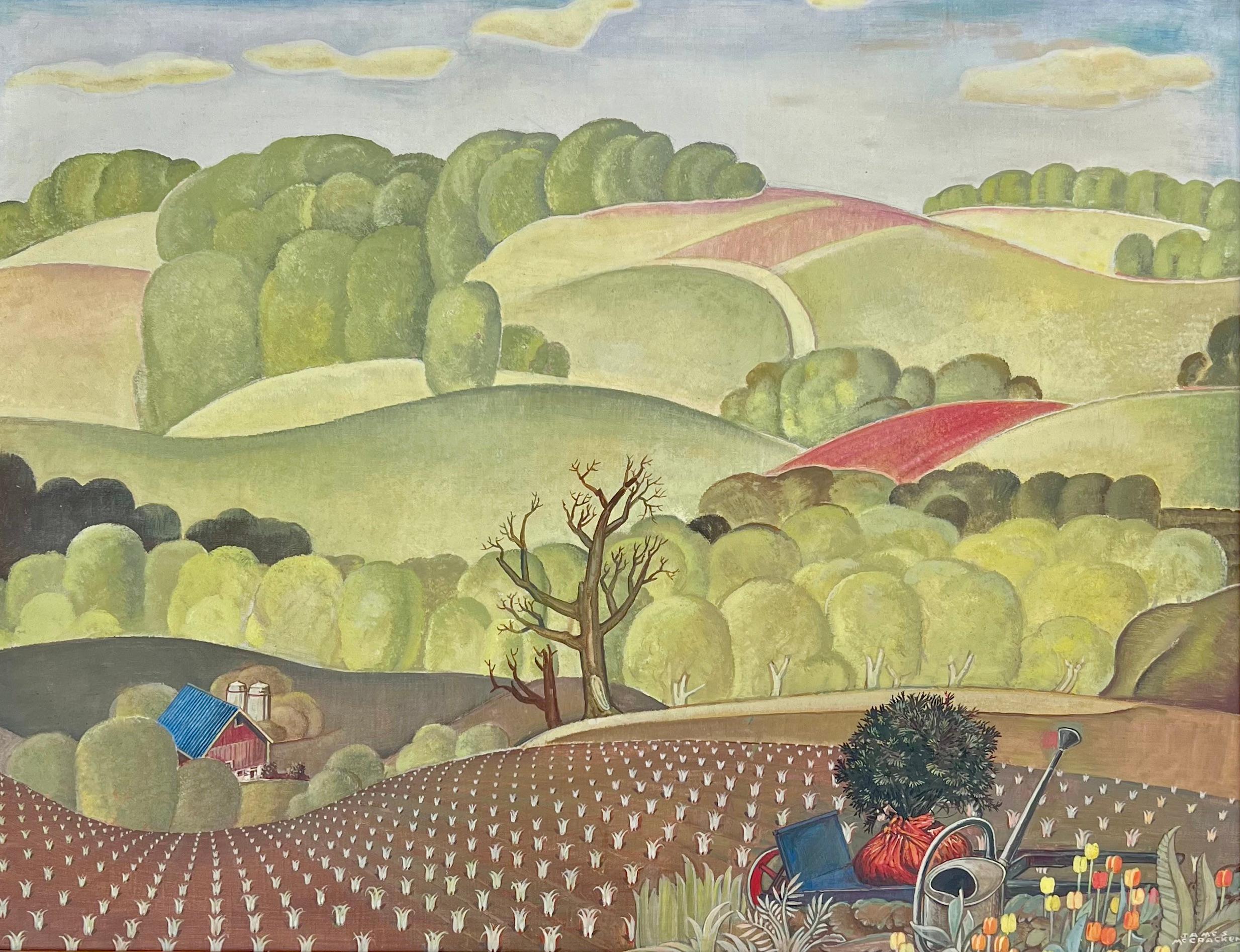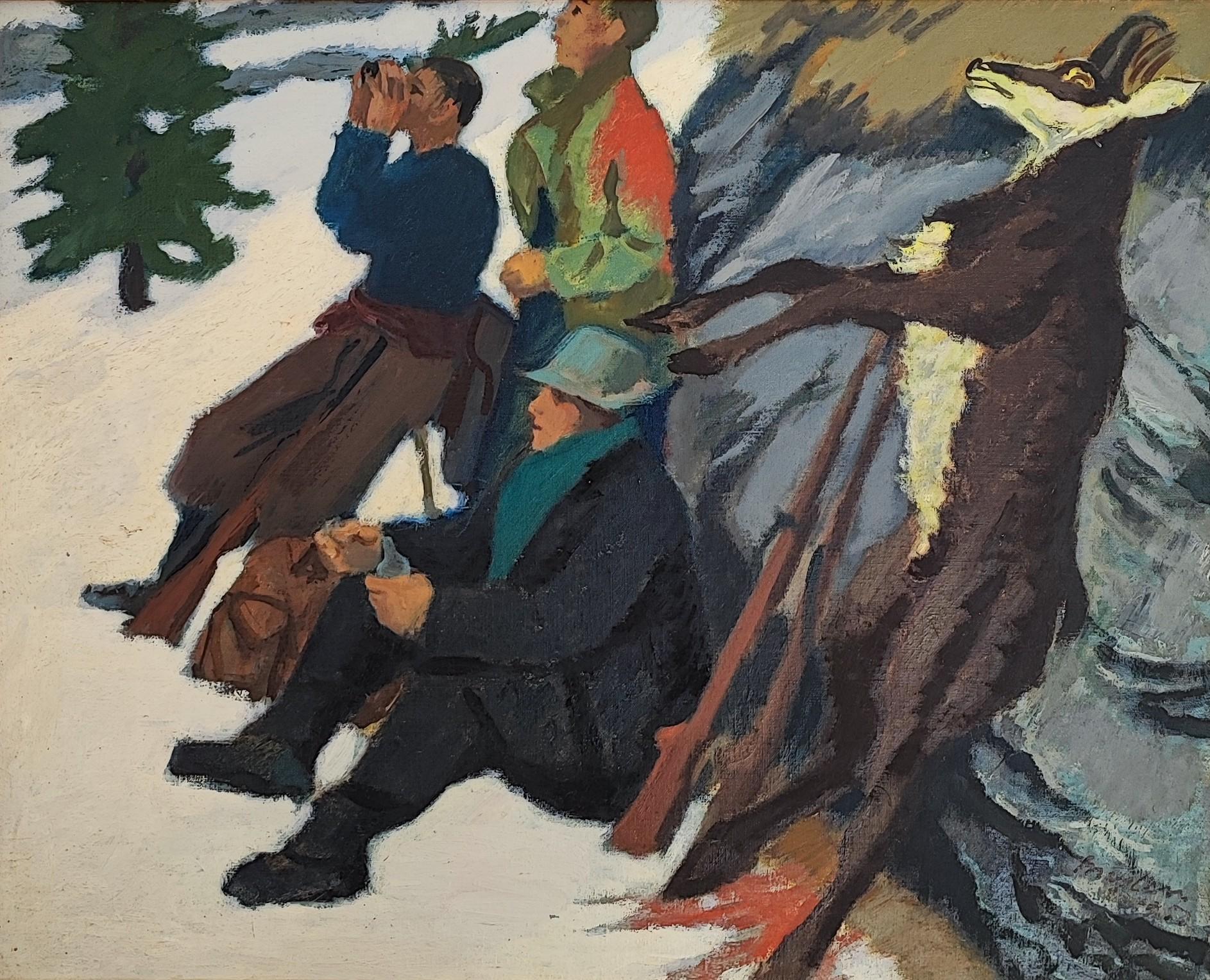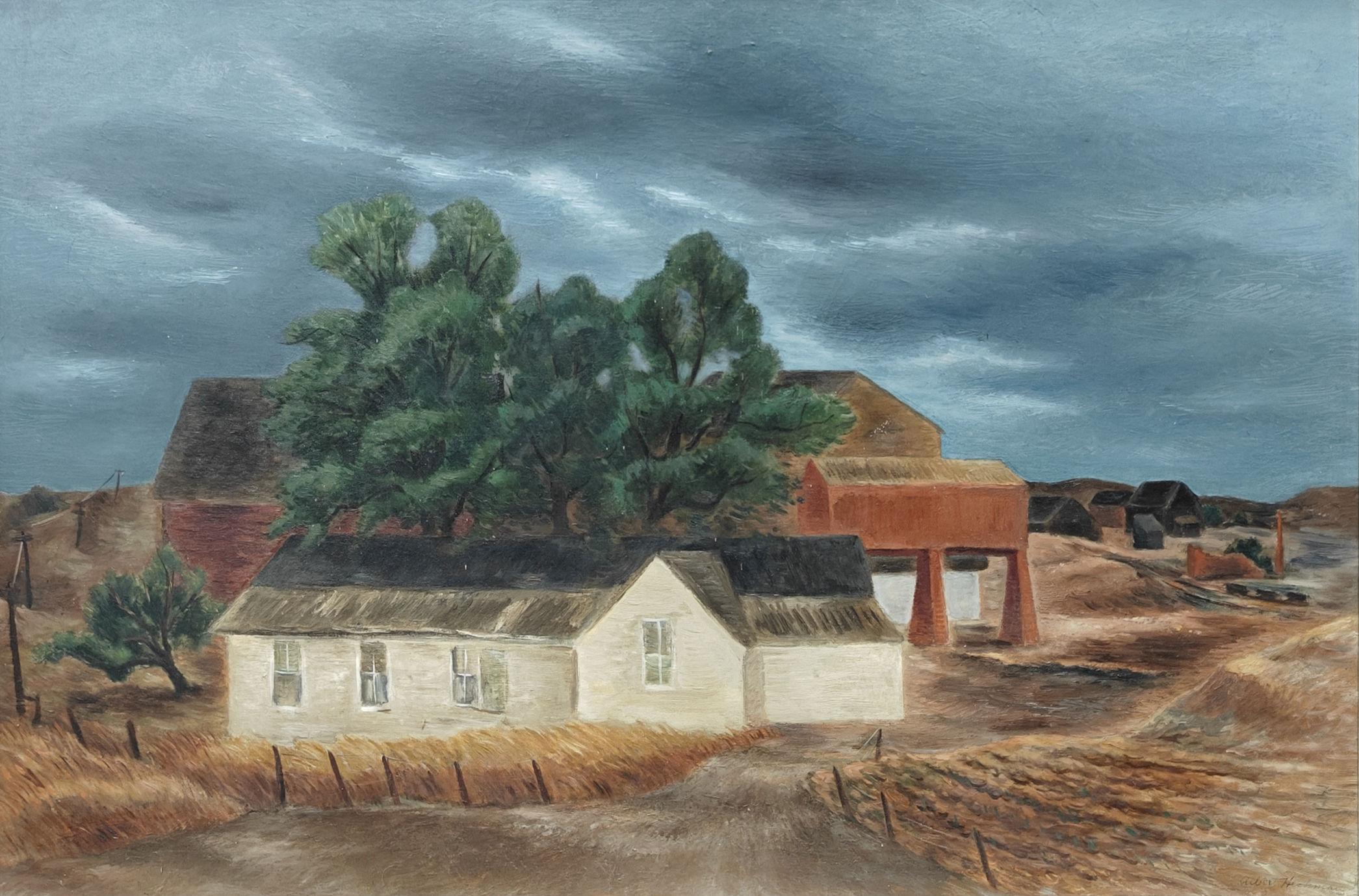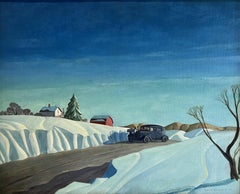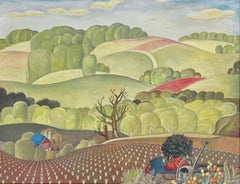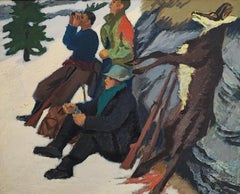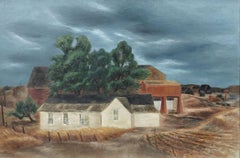Items Similar to Rabbit Hunters
Want more images or videos?
Request additional images or videos from the seller
1 of 3
Roger MedearisRabbit Hunters1947
1947
$35,000
£26,430.60
€30,260.61
CA$49,429.15
A$53,964.80
CHF 28,291.54
MX$655,423.26
NOK 353,315.22
SEK 333,623.78
DKK 225,863.19
About the Item
Rabbit Hunters, egg tempera on Masonite, 12 x 9 inches, 1947, signed and dated lower left, signed, titled and dated verso “Rabbit Hunters Egg Tempera Roger Medearis 1947,” exhibited at Medearis' solo show at Kende Galleries, New York, in 1949 (Medearis’ record book, a copy of which is held by Vose Galleries in Boston, MA, indicates this is painting “No. 23” and that is was completed in 1947 and sold via Kende Galleries (at Gimbel Brothers) in New York in November, 1949, to a private New York City collector); probably original frame.
Rabbit Hunters shows Roger Medearis at his best. Painted while the artist lived in Connecticut during the time in his life when he was most devoted to his artistic craft, the work combines the regionalism for which Medearis is best known with a meaningful dose of Magic Realism that sets his work apart from the late 1940s art of many of his contemporaries who also continued to explore the American Scene in a more straight-forward manner. Medearis uses his characteristic egg tempera medium to render a high contrast landscape with hunters and a dog pursuing their quarry. The undulating hills, spare trees, and rocky outcrops form an uneasy, but organic whole. The clouds in the upper center sit above the trees and form clearly delineated and unintelligible symbols in the sky. In the tiny details and meticulous brush strokes, we see the attributes which have caused scholars and curators to compare Medearis to the Dutch master Bruegel. Rabbit Hunters comes from Medearis’ most desirable period before he took a hiatus from the art world during much of the 1950s and 1960s. The painting was exhibited at Medearis’ critically acclaimed 1949 solo exhibition at New York’s Kende Gallery, where it sold to a private collector.
Thomas Hart Benton said that Roger Medearis was his best pupil at the Kansas City Art Institute during the late 1930s. The son of a Baptist preacher, Medearis was born in Missouri, where he spent the first eight years of his life before moving with his family to Oklahoma in 1928. Surrounded by illustrated magazines, Medearis was inspired to become an artist by the works of Norman Rockwell. At the age of eighteen, Medearis enrolled in the Kansas City Art Institute where he studied under Thomas Hart Benton and soaked up the prevailing regionalist aesthetic of the day. Medearis’ work focused on the people and places he knew from the Midwest. As a student, Medearis achieved quick success with representation in New York City by Associated American Artists. When World War II erupted, Medearis shifted his focus to propaganda leaning paintings designed to inspire support for the war effort. In 1942, Medearis joined the navy and worked for three years drawing naval and other charts for the armed forces. After he was released from service in 1946, he moved to Connecticut and devoted his energies to returning to life as a professional artist. He had two successful solo shows in New York and 1949 and 1950, the latter of which included his painting Family Reunion, which was selected for the Metropolitan Museum of Art’s exhibition American Painting Today 1950-1951. Despite his success, Medearis became disheartened that the American Scene, even with his touches of magic realism, was out of favor as abstract expressionism took a firm grip on the art world. Medearis wrote, “It seemed to me that the New York artists had thrown off all restraint and were making whoopee with paint, while I continued to struggle with the American Scene. I knew that I could never part company with the Regionalists. Their people were my people, and their land, my land.” In the early 1950s, Medearis put his artistic career on pause, and he did not return to painting professionally until the mid-1960s. Medearis’ return to painting was a triumph, as he was able to sell most of what he painted during the last thirty years of his life. Medearis moved to Southern California and many of his later works explore the American West. Medearis’ work is in the collections of many museums, including the Smithsonian American Art Museum, The Spencer Museum of Art, Crystal Bridges Museum of American Art, and the Huntington Library, Art Museum and Botanical Gardens, which held a retrospective for the artist in 2012. Medearis is listed in Who was Who in American Art and other standard references.
- Creator:Roger Medearis (1920 - 2001, American)
- Creation Year:1947
- Dimensions:Height: 9 in (22.86 cm)Width: 12 in (30.48 cm)Depth: 3 in (7.62 cm)
- More Editions & Sizes:9 x 12 inchesPrice: $35,000
- Medium:
- Movement & Style:
- Period:
- Condition:
- Gallery Location:Los Angeles, CA
- Reference Number:1stDibs: LU1859211388962
About the Seller
5.0
Vetted Professional Seller
Every seller passes strict standards for authenticity and reliability
1stDibs seller since 2022
17 sales on 1stDibs
Typical response time: <1 hour
- ShippingRetrieving quote...Shipping from: Los Angeles, CA
- Return Policy
Authenticity Guarantee
In the unlikely event there’s an issue with an item’s authenticity, contact us within 1 year for a full refund. DetailsMoney-Back Guarantee
If your item is not as described, is damaged in transit, or does not arrive, contact us within 7 days for a full refund. Details24-Hour Cancellation
You have a 24-hour grace period in which to reconsider your purchase, with no questions asked.Vetted Professional Sellers
Our world-class sellers must adhere to strict standards for service and quality, maintaining the integrity of our listings.Price-Match Guarantee
If you find that a seller listed the same item for a lower price elsewhere, we’ll match it.Trusted Global Delivery
Our best-in-class carrier network provides specialized shipping options worldwide, including custom delivery.More From This Seller
View AllRites of Winter
By Georgina Klitgaard
Located in Los Angeles, CA
Rites of Winter, by 1939, oil on canvas, 32 x 40 inches, exhibited: 134th Annual Exhibition of the Pennsylvania Academy of Fine Arts, Philadelphia, PA, January 29 – March 5, 1939, no...
Category
1930s American Modern Landscape Paintings
Materials
Canvas, Oil
Landscape
Located in Los Angeles, CA
Landscape, c. 1930-40s, oil on panel, signed lower right, 16 x 20 inches
Jeanette Maxfield Lewis was a California-based landscape painter and etcher. Born in Oakland, she spent much...
Category
1930s American Modern Landscape Paintings
Materials
Oil, Panel
Untitled
Located in Los Angeles, CA
Untitled, c. 1940s, oil on Masonite, signed lower right, 19 ¾ x 25 ¾ inches
Ava Vorhaus Gabriel was a New York-based painter, lithographer, and designer. Born in Larchmont, Gabriel ...
Category
1940s American Modern Landscape Paintings
Materials
Masonite, Oil
RFD#1
By Dale Nichols
Located in Los Angeles, CA
RFD #1, 1937, oil on canvas, signed and dated lower right, titled verso, 24 x 30 inches
Iowa had Grant Wood. Missouri had Thomas Hart Benton. Kansas had John Steuart Curry. And, Neb...
Category
1930s American Modern Landscape Paintings
Materials
Canvas, Oil
$75,000
Johnny Walker’s Place
By Georgina Klitgaard
Located in Los Angeles, CA
Johnny Walker’s Place, by 1929, oil on canvas, signed lower right, 34 x 42 inches, exhibited 1) 28th International Exhibition of Paintings, Carnegie Institute, Pittsburgh, PA, Octobe...
Category
1920s American Modern Landscape Paintings
Materials
Canvas, Oil
The Ledge
By Georgina Klitgaard
Located in Los Angeles, CA
Georgina Klitgaard (1893 – 1976) The Ledge, by 1931, oil on canvas, signed lower right, 32 1/8 x 50 1/8 inches, exhibited: 1) 44th Annual Exhibition of American Paintings & Sculptur...
Category
1930s American Modern Landscape Paintings
Materials
Canvas, Oil
You May Also Like
WPA Landscape American Scene Social Realism Mid 20th Century Modern Farm Rural
By James McCracken
Located in New York, NY
WPA Landscape American Scene Social Realism Mid 20th Century Modern Farm Rural
James McCracken (1875 – 1967)
WPA Landscape
28 x 36 inches
Oil on canvas, c. 1930s
Signed lower right
...
Category
1930s American Modern Landscape Paintings
Materials
Canvas, Oil
Hunting game
By Henry Meylan
Located in Genève, GE
Work on wood
Golden wooden frame
73 x 87 x 4 cm
Category
1950s Figurative Paintings
Materials
Oil
"Glasco Landscape" Albert Heckman, circa 1940 New York Modernist Landscape
By Albert Heckman
Located in New York, NY
Albert Heckman
Glasco Landscape, circa 1940
Signed lower right
Oil on canvas
25 1/4 x 39 1/2 inches
Albert Heckman was born in Meadville, Western Pennsylvania, 1893. He went to New York City to try his hand at the art world in 1915 after graduating from high school and landing a job at the Meadville Post Office. In 1917, at the age of 24, Heckman enrolled part-time in Teachers' College, Columbia University's Fine Arts Department to begin his formal art education. He worked as a freelance ceramic and textile designer and occasionally as a lecturer at the Metropolitan Museum of Art. In the early 1920s, at the age of almost 30, he graduated with a Bachelor of Arts degree from Columbia Teachers College. He was especially impacted by his instructor at Columbia, Arthur Wesley Dow.
After graduating, he was hired by the Teachers' College as a Fine Arts instructor. He stayed with Columbia Teachers' College until 1929, when he left to attend the Leipzig Institute of Graphic Arts in Leipzig, Germany. Isami Doi (1903-1965), who was born in Hawaii, was arguably his most impressive student at Columbia. Doi is now regarded as one of the most prominent artists hailing from Hawaii. Heckman became an active member and officer of the Keramic Society and Design Guild of New York in the 1920s as part of his early commercial art career. The Society's mission was to share knowledge and showcase textile and ceramic design exhibits.
In 1922, Heckman married Florence Hardman, a concert violinist. Mrs. Heckman's concert schedule during the 1920s kept Albert and Florence Heckman apart for a significant portion of the time, but they spent what little time they had together designing and building their Woodstock, New York, summer house and grounds. A small house and an acre of surrounding land on Overlook Mountain, just behind the village of Woodstock, were purchased by Albert and Florence Heckman at the time of their marriage. Their Woodstock home, with its connections, friendships, and memories, became a central part of their lives over the years, even though they had an apartment in New York City.
Heckman's main artistic focus shifted to the house on Overlook Mountain and the nearby towns and villages, Kingston, Eddyville, and Glasco. After returning from the Leipzig Institute of Graphic Arts in 1930, Mr. Heckman joined Hunter College as an assistant professor of art. He worked there for almost thirty years, retiring in 1956. Throughout his tenure at Hunter, Mr. Heckman and his spouse spent the summers at their Woodstock residence and the winters in New York City. They were regular and well-known guests at the opera and art galleries in New York. Following his retirement in 1956, the Heckmans settled in Woodstock permanently, with occasional trips to Florida or Europe during the fall and winter. Mr. Heckman's close friends and artistic career were always connected to Woodstock or New York City. He joined the Woodstock art group early on and was greatly influenced by artists like Paul and Caroline Rohland, Emil Ganso, Yasuo Kuniyoshi, Andre Ruellan, and her husband, Jack...
Category
1940s American Modern Figurative Paintings
Materials
Canvas, Oil
Mid-Summer
Located in Dallas, TX
Lloyd Goff studied at the Art Students League, and has work in the collections of the Smithsonian American Art Museum, Whitney Museum of American Art, and T...
Category
1930s American Modern Landscape Paintings
Materials
Canvas, Oil
Fall Hunters
By Hannah Barrett
Located in Boston, MA
Hannah Barrett, American (b.1966), Fall Hunters, 2014
Hannah Barrett’s paintings imagine a colorful, absurdist world inhabited by eccentrics of ambiguous genders and time periods. ...
Category
21st Century and Contemporary Contemporary Figurative Paintings
Materials
Oil, Canvas
$10,000 Sale Price
20% Off
Mid Century Figurative Landscape -- The Search
By Winifred Lucy Shaffer
Located in Soquel, CA
Mid Century Figurative Landscape - The Search
A dreamlike landscape by Winifred Lucy Shaffer (American, 20th Century). Several figures are clustered together in a forest setting. Th...
Category
1960s Modern Figurative Paintings
Materials
Canvas, Oil, Stretcher Bars
$1,204 Sale Price
20% Off
More Ways To Browse
Vose Galleries
Hunter And Dog
Roger Rabbit
Gimbel Brothers
Constable John
Desert Oil Painting
French Countryside Paintings
Flower Market
Golden Gate Bridge
Irish Oil Painting
Rockport Art
Roman Ruins
Wimbledon Art
American Realism Painting
Dutch School Oil Paintings
Lily Pond
Nature Impressionist Paintings
River Scene Paintings
